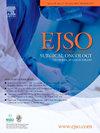丝裂霉素与奥沙利铂对结直肠癌HIPEC的争论-一项最新的系统综述和荟萃分析
IF 3.5
2区 医学
Q2 ONCOLOGY
引用次数: 0
摘要
在PRODIGE-7试验之后,外科医生已经从奥沙利铂转向使用基于丝裂霉素的HIPEC治疗结肠直肠腹膜转移。虽然临床前研究已经证明丝裂霉素优于奥沙利铂,但临床研究报告的结果却不尽相同。荟萃分析的目的是确定结肠直肠腹膜转移细胞减少后最有效的药物。方法检索PubMed、Cochrane Library、Scopus、CINHAL (EBSCO)和谷歌Scholar数据库,检索的概念为:结直肠、腹膜、细胞减少、丝裂霉素和奥沙利铂。使用纽卡斯尔-渥太华量表评估偏倚风险,使用GRADE Pro工具评估证据的确定性。分析采用对数风险比作为生存数据的结果测量。所有合成均采用随机效应模型,并以MMC为参考,报道了基于奥沙利铂的HIPEC。结果13项研究3406例患者被纳入定量荟萃分析。10项研究中总生存率的合并风险比为1.03 (95% CI: 0.786-1.349)。6项研究报告无病生存,合并风险比为0.941 (95% CI: 0.683-1.297)。两种生存估计都有中等程度的统计异质性。由于研究的非随机性质、临床和统计异质性、由于不受控制的测量混淆、选择偏倚和不平等的随访时间导致严重的偏倚风险,所有结果的证据的确定性都很低。我们的系统回顾和荟萃分析发现MMC和基于奥沙利铂的HIPEC在生存结果和术后发病率方面没有显著差异。本文章由计算机程序翻译,如有差异,请以英文原文为准。
The Mitomycin versus Oxaliplatin debate on HIPEC in colorectal cancers - An updated systematic review and Meta-analysis
Introduction
Following the PRODIGE-7 trial, surgeons have shifted to the use of Mitomycin-based HIPEC from Oxaliplatin for colorectal peritoneal metastasis. While preclinical studies have demonstrated the superiority of Mitomycin over oxaliplatin, clinical studies report variable results. The objective of the meta-analysis was to determine the most efficacious drug after cytoreduction for colorectal peritoneal metastasis.
Methods
he databases searched were PubMed, Cochrane Library, Scopus, CINHAL (EBSCO), and Google Scholar based on the following concepts: colorectal, peritoneal, cytoreduction, Mitomycin, and Oxaliplatin. The risk of bias was assessed using the Newcastle-Ottawa scale and certainty of the evidence was assessed using the GRADE Pro tool. The analysis was carried out using the log hazard ratio as the outcome measure for survival data. All syntheses used the Random-effects model and were reported for Oxaliplatin-based HIPEC with MMC as the reference.
Results
Thirteen studies with 3406 patients were included in the quantitative meta-analysis. The pooled hazard ratio for overall survival was 1.03 (95 % CI: 0.786–1.349) from ten studies. Six studies reported disease-free survival and the pooled hazard ratio was 0.941 (95 % CI: 0.683–1.297). Both survival estimates had moderate statistical heterogeneity. The evidence was of very low certainty for all the outcomes due to the non-randomized nature of studies, clinical and statistical heterogeneity, serious risk of bias due to uncontrolled measured confounding, selection bias, and unequal follow-up durations.
Conclusion
Our systematic review and meta-analysis found no significant difference in survival outcomes or postoperative morbidity between MMC and Oxaliplatin-based HIPEC.
求助全文
通过发布文献求助,成功后即可免费获取论文全文。
去求助
来源期刊

Ejso
医学-外科
CiteScore
6.40
自引率
2.60%
发文量
1148
审稿时长
41 days
期刊介绍:
JSO - European Journal of Surgical Oncology ("the Journal of Cancer Surgery") is the Official Journal of the European Society of Surgical Oncology and BASO ~ the Association for Cancer Surgery.
The EJSO aims to advance surgical oncology research and practice through the publication of original research articles, review articles, editorials, debates and correspondence.
 求助内容:
求助内容: 应助结果提醒方式:
应助结果提醒方式:


